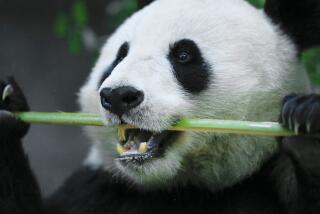What’s Black and White and Older All Over?
WASHINGTON — The National Zoo held a panda party for its most prominent residents Thursday, celebrating the birthdays of Mei Xiang and Tian Tian.
Mei Xiang, the female, turned 4 on July 22, and Tian Tian will turn 5 on Aug 27. The zoo picked a date in between, and will focus on the endangered species throughout August.
“Today we’re really celebrating all giant panda birthdays,” zoo director Lucy Spelman said. “Today is about our giant pandas here and what we’ve learned about them in the past year and a half, what we will continue to learn about them and how it applies to the wild giant panda population.”
As thousands of guests ate slices of a cake decorated with bamboo and replicas of the pandas, Mei Xiang lapped at a block of ice with fruit in the middle. Tian Tian took a nap in his air-conditioned grotto and was to have his frozen treat after he awoke, Spelman said.
Both pandas were born at a China research and conservation center dedicated to studying the giant panda. They came to the U.S. in December 2000 and are on loan for 10 years to the zoo, which will pay the Chinese government $10 million in return. They are the zoo’s second pair of pandas, replacing Ling-Ling, who died in 1992 and Hsing-Hsing, who died in 1999.
The pandas lived together at first but were separated after their first breeding season in May. The 262-pound Tian Tian had become too aggressive in his play with the 217-pound Mei Xiang, and zoo officials feared he might hurt her.
They were kept apart while curators studied the pandas’ behavior, although they could see and smell each other. They were reunited July 25, after it became apparent that the two wanted to be together.
“They are much more calm and adult-like in their play, right now,” Spelman said. “It’s not the chirping, rambunctious play that they did when they first arrived.”
Scientists hope that their second mating season will be more successful than the first.
“Both of them are going through puberty right now and are just reaching maturity,” panda curator Lisa Stevens said.
There’s a good chance the two will mate next year, Spelman said. However, scientists realize successful reproduction would be a longshot. No giant panda cub born at the National Zoo has ever survived longer than a few hours.
Zoo officials are also studying the pandas’ everyday behavior so they can customize a new habitat that will anchor an Asian animal area, which they hope to begin building by the end of the year.
More to Read
Sign up for Essential California
The most important California stories and recommendations in your inbox every morning.
You may occasionally receive promotional content from the Los Angeles Times.










